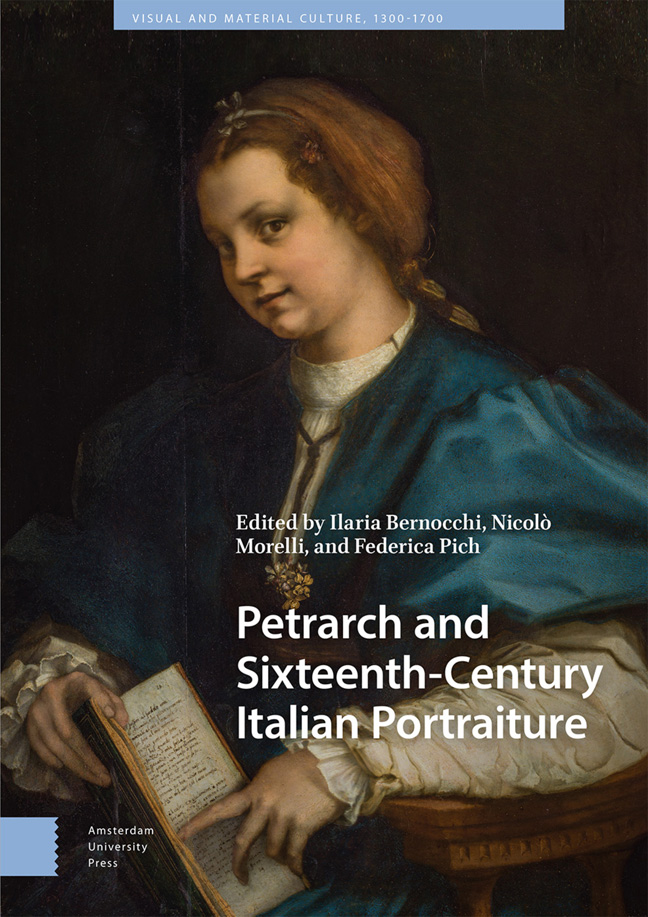Book contents
- Frontmatter
- Contents
- List of Illustrations
- Acknowledgements
- 1 Introduction
- 2 Widows, Poetry, and Portraits: Livia Spinola and Francesca Turina on the Portraits of their Dead Husbands
- 3 In Medusa's Eyes: Petrification and Marble Portraits in Late Sixteenth-Century Poetry
- 4 The Portrait of the Ideal Woman: Petrarch in Conduct Literature Texts for and about Women
- 5 Anti-Petrarchist Portraiture or a Different Petrarchist Portraiture?: A Literary Outlook on Some Non-Idealised Female Sitters in Renaissance Art
- 6 The Shadow of Petrarch: Benedetto Varchi and Agnolo Bronzino on Portraiture
- 7 Double Portraits of Petrarch and Laura in Print (c. 1544–1600)
- 8 Sonnet ‘Diptychs’ and Double Portraits: Figurative Allusions in Sixteenth-Century Encomiastic Poetry
- 9 Images of Women from Subject to Frame in Printed Portrait Books
- Bibliography
- Index
6 - The Shadow of Petrarch: Benedetto Varchi and Agnolo Bronzino on Portraiture
Published online by Cambridge University Press: 22 February 2024
- Frontmatter
- Contents
- List of Illustrations
- Acknowledgements
- 1 Introduction
- 2 Widows, Poetry, and Portraits: Livia Spinola and Francesca Turina on the Portraits of their Dead Husbands
- 3 In Medusa's Eyes: Petrification and Marble Portraits in Late Sixteenth-Century Poetry
- 4 The Portrait of the Ideal Woman: Petrarch in Conduct Literature Texts for and about Women
- 5 Anti-Petrarchist Portraiture or a Different Petrarchist Portraiture?: A Literary Outlook on Some Non-Idealised Female Sitters in Renaissance Art
- 6 The Shadow of Petrarch: Benedetto Varchi and Agnolo Bronzino on Portraiture
- 7 Double Portraits of Petrarch and Laura in Print (c. 1544–1600)
- 8 Sonnet ‘Diptychs’ and Double Portraits: Figurative Allusions in Sixteenth-Century Encomiastic Poetry
- 9 Images of Women from Subject to Frame in Printed Portrait Books
- Bibliography
- Index
Summary
Abstract
Petrarch's two sonnets on Simone Martini's portrait of Laura (Rvf 77 and 78) initiated a widely successful poetic genre in the sixteenth century: sonnets on portraits. Texts belonging to this genre often offered theoretical considerations on the issue of paragone between poetry and painting. Benedetto Varchi's Due Lezzioni (1550) closely analyses this subject by building on Petrarch's lyric poems and Triumphs. While Petrarch's decisive impact on the Renaissance debate on ut pictura poësis has been widely emphasised, less attention has been devoted to his influence on portraiture, especially on the portraits by painter Agnolo Bronzino, a poet himself and a contributor to the paragone debate. This essay investigates the extent to which the intellectual dialogue between Varchi and Bronzino was inspired by Petrarch's ideas on paragone, which he expressed in his vast production in Latin and in the vernacular.
Keywords: portraiture, sonnet, ut pictura poësis
Agnolo Bronzino's prolific work as a portrait painter began under the sign of Petrarch and of the poet's cult in sixteenth-century Italy. Before his departure for the court of Guidobaldo II Della Rovere in 1530, Bronzino was commissioned by Benedetto Varchi to execute the Portrait of Lorenzo Lenzi, today in the collections of the Castello Sforzesco in Milan (Fig. 6.1).
The painting has drawn unceasing scholarly attention since 1990, when Alessandro Cecchi revealed the identity of the sitter and the names of both the patron and the artist, thereby correcting a long-standing attribution to Jacopo Pontormo. In what is believed to be his first portrait, Bronzino orchestrates the combination of multiple layers of meaning resulting from a close collaboration with Varchi. The portrait includes an open book in which are transcribed two sonnets in beautifully legible handwriting (Fig. 6.2).
On the left page is the sonnet ‘Famose Frondi, de’ cui santi honori’, written by Varchi himself in praise of the young Lorenzo Lenzi, the nephew of Giovanni Gaddi, with whom he had become close friends at the end of the 1520s:
Famose Frondi, de’ cui santi honori
Per non so qual del Ciel fero Pianeta
Rado hoggi s’horna Cesare o Poeta
Mercè del guasto Mondo, & pien d’errori
Chi sarà mai, che degnamente honori
Il bel che in Voi si dolcemente acqueta
I Venti, & le Tempeste, e ’n Ciel i lieta
Ogni Anima gentil del Volgo fuori?
- Type
- Chapter
- Information
- Petrarch and Sixteenth-Century Italian Portraiture , pp. 129 - 156Publisher: Amsterdam University PressPrint publication year: 2023



